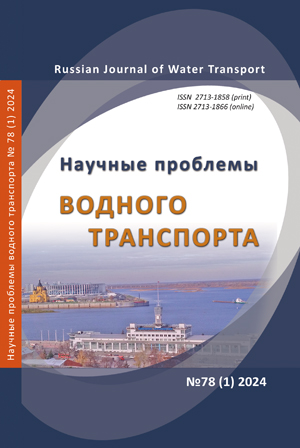Features of creating a mathematical model and its implementation for modeling the hydrodynamics of a river flow in the lower district of the Oka r.
Abstract
The development of computer technology and the complication of engineering problems have made mathematical modeling an integral part of design work in the construction of complex water transport and bridge hydraulic structures. This allows, with a minimum of labor and intellectual costs, to obtain maximum information about the nature of the future interaction between the future structure and the river channel. Modeling the hydrodynamics of rivers is associated with a complex topology of the computational bottom area. In addition to this, one has to solve three-dimensional problems based on the Navier-Stokes equations. The latter, in combination with the problem of the ratios of the dimensions of length, width and depth, pose additional problems in the way of practical implementation and obtaining results. These problems are especially pronounced when modeling large rivers in the European part of Russia, such as the Oka and Volga. This is due to the fact that the planned dimensions of the river flow are hundreds of times greater than the depth values, and a strict approximation of the computational domain requires the use of equal-dimensional, computational elements. These problems can be circumvented by the use of modern CAD/CAE computing technologies in combination with special settings of the iterative solver. The results of applying these achievements of computational technologies in relation to solving the problem for the lower reaches of the river. Oka is presented in the article.
References
Липатов И.В. Монография «Гидродинамика речных потоков и ее влияние на эксплуатационные параметры судоходных гидротехнических сооружений» - Н.Новгород изд, ВГУВТ с. 106
Патанкар С. Численные методы решения задач теплообмена и динамики жидкости / Пер. с англ. – М.: Энергоатомиздат, 1984. – 152 с.
Launder, B.E., and Spalding, D.B. 1974. ‘The numerical computation of turbulent flows’, Comp. Meth. in Appl. Mech. and Eng., 3, pp. 269-289.
Rodi, W. 1979. ‘Influence of buoyancy and rotation on equations for turbulent length scale’, Proc. 2nd Symp. on Turbulent Shear Flows.
El Tahry, S.H. 1983. ‘k-equation for compressible reciprocating engine flows’, AIAA J. Energy, 7, No. 4, pp. 345–353.
Gutachten über die seitliche Einleitung von Überschusswasser in den Einfahrtsbereich der Schleuse Nürnberg – технический отчет BAW. Автор Кастен Торенц, Липатов И.В. - Карлсруэ - Bundesanstalt für Wasserbau (BAW) -Nr. 3.03.10043.00 – Dezember 2003.
Schlichting, H. “Boundary Layer Theory”. 6th Edition, McGraw-Hill, New York. 1968.
Идельчик “Справочник по гидравлическим сопротивлениям”
Гришанин К.В. «Основы динамики русловых потоков», М. Транспорт 1996 г.
Атлас Единой глубоководной системы России.
H. Jin and R. I. Tanner, "Generation of Unstructured Tetrahedral Meshes by Advancing Front Technique", Int. J. Numer. Methods Eng., 36, 1805-1823 (1993).
R. Lohner and P. Parikh, "Generation of Three Dimensional Unstructured Grids by the Advancing-Front Method", Int. J. Numer. Methods Fluids, 8, 1135-1149 (1988)
J. Peraire, J. Peiro, L. Formaggia, K. Morgan and O. C. Zienkiewicz, "Finite Element Euler Computations in Three Dimensions", Int J. Numer. Methods Eng., 26, 2135-2159 (1988).
Copyright (c) 2024 Russian Journal of Water Transport

This work is licensed under a Creative Commons Attribution 4.0 International License.













